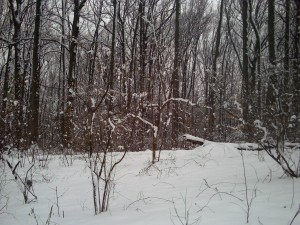
Early this morning a heavy, wet snow has fallen. Caught on the millions of branches of  thousands of trees and shrubs, this makes for an astounding visual landscape. The sounds of the city are muffled and the fresh powder is pleasant to walk through.  This photograph is taken at the exact location of the first photograph in the intro to the Sanguine Root, where the bloodroot patch grows.  This area was an early restoration project for us.  The multi-stemmed spicebush (Lindera benzoin) in the foreground was not much more than a lump under a network of Multi-flora Rose,  Oriental Bittersweet, and Japanese Honeysuckle.
Now, Â three years later it is a thriving part of the forest understory. Although we haven’t seen it yet, Spicebush is the host for the Larvae of the Spicebush Swallowtail butterfly (Papilio troilus). Spicebush is also a great source of nectar early in the season.
Tulip Poplar (Liriodendron tulipifera) saplings are now growing in the area. Â The backround forest in the picture is a startling batch of mature Tulip poplars. Also uncovered in the project area was an American Elm (Ulmus americana). Every year we have to return to this site to remove Multi-flora Rose, Bittersweet and Japanese honeysuckle seedlings.
Most recently, and with great alarm, the newly emerging invasive Mile-A-Minute (Persicaria perfoliata syn. Polygonum perfoliatum) was found for the first time on this site.  Not surprising being that there is an infestation of this in the park near the entrance to Lotus Road, maybe 400 feet away.  We are extremely vigilant about this emerging invasive.  While out of our current project scope, the Mile -a-Minute infestation is being taken seriously by Fairmount Park staff, who have organized a volunteer  event  which we participated in, to remove the invasives in this problematic area.
In the heart of winter, Mile-a-Minute, an invasive from Asia, imported to Pennsylvania in the 1930s, is the last thing we think about. Â It is an annual that dies back in the winter, but re-seeds itself vigorously and grows like it’s namesake.
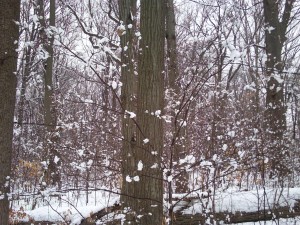
The snow collected on this beautiful woodland specimen of Flowering Dogwood (Cornus florida) this morning. In a sense, winter created a faux inflorescence on this dogwood tree, with little balls of snow mimicking a floral display. Look at that! Â Who needs Spring when we can have this?
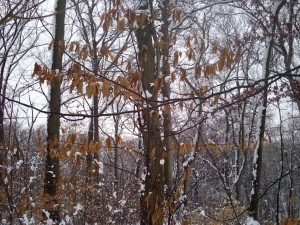
In perfect Fagacae form, this Chestnut tree is holding its leaves into the winter, like the beeches and oaks in its family.
In this picture, note the line that demarcates the tops of the trees and the sky.  This Chestnut tree is growing on a plateau situated next to a slope that drops down to Indian Creek.  The tops of the trees in the backround, not much above eye-level, are  almost mature oaks, beeches and Tulip poplars. This image demonstrates the height of the plateau, as well as the degree with which the slope precipitates. The winter time is the best time to photograph or just visualize for yourself, the lay of the land, where geographical qualities such as slope grades, floodplains, and hilltops are the most visible.
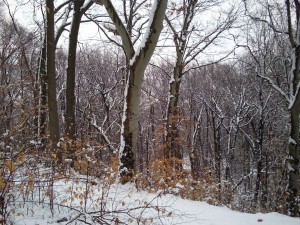
In front of the beech tree at center is a trail, which we call the ‘Upper Trail’, which follows along the top of the hill, tracing the contour of the landscape. This makes for a pleasant woodland walk, with great views, and a gentle slope. There are several points along this trail where new trails break off, dropping down to Indian Creek, giving us the opportunity to visit the creek and its environs. Another trail follows along Indian creek, which we call the ‘Lower Trail’.
In the photo above we get a sense of the landscape. A ravine lies behind that Beech tree. A precipitous drop, created by Indian creek over millions of years of erosion, makes for the transformation of a woodland walk into a hike.
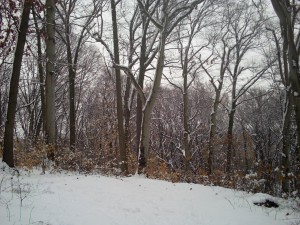
This edge of the plateau area displayed in the past few photographs is our favorite part of Morris Park. Â There are very few invasives in this area, a great amount of mature oak, Beech, and Tulip Poplar trees, and a large amount of smaller trees in various stages of maturity. Also a great diversity of native flora, from a bounty of spring ephemerals, Â a shrub layer, to summer and fall flowering plants, a diversity of mushrooms and parasitic plants. The area gets great summer breezes and commands a spectacular view of the Indian Creek ravine.



Good read. Thanks for this.